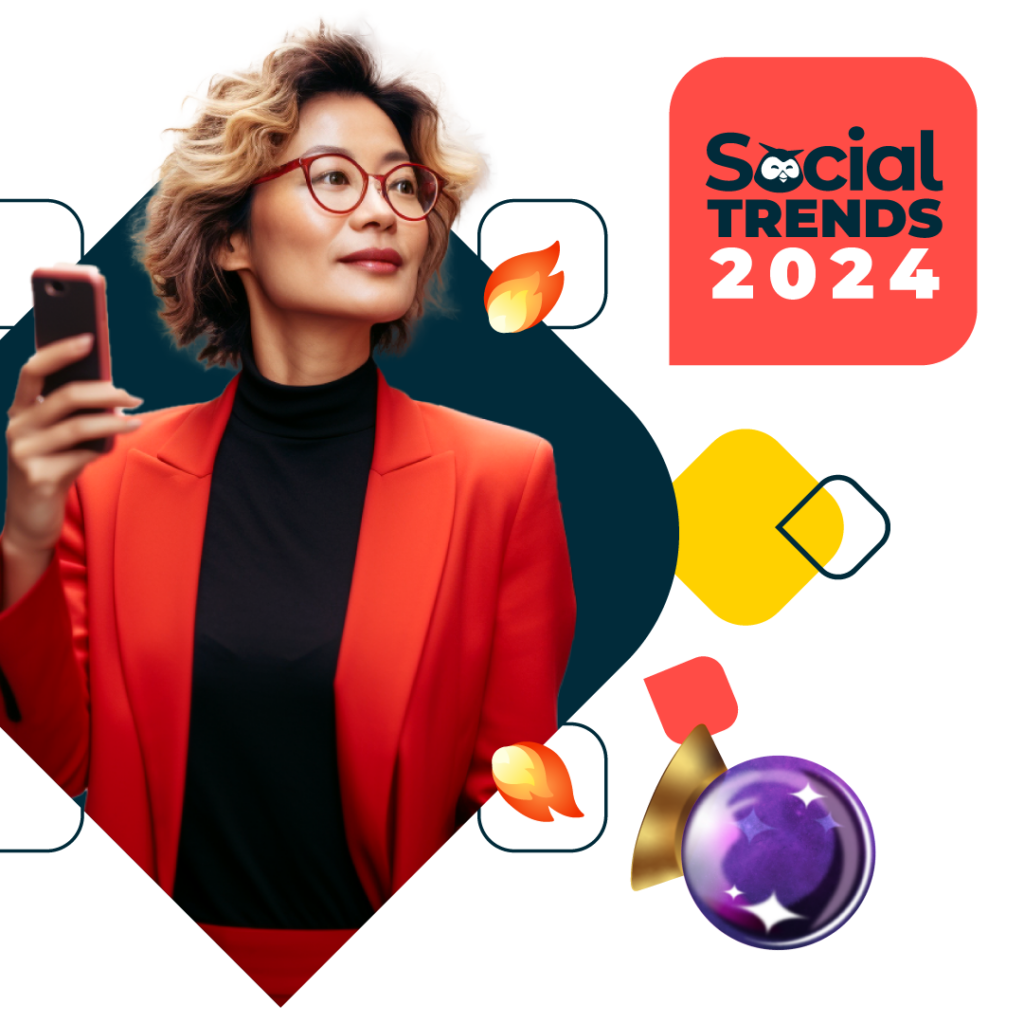Welcome to social media in 2024, where trends change faster than Taylor Swift fan theories. There are hot new platforms, fresh ways to shop, and countless algorithm updates. It’s enough to make even the savviest heads spin.
But no need to spiral, friends, because we’ve done the digging for you. Take this blog post as permission to stop obsessively checking every app in search of the hottest new social media trends.
Get our 2024 Social Trends report, and dig into the juicy data that’ll help you reach your goals in 2024—which is shaping up to be social’s best year yet.
1. Text-only posts are the sleeper hit of the year (and X remains on top)
While the shakeup at X seems to have stabilized in recent months, the uncertainty at the platform did give plenty of other text-based apps an opportunity to eat up some market share in 2023.
Mastodon, for example, has 1.7 million monthly active users. The Jack Dorsey-funded Bluesky Social is invite-only (exclusive!) but boasts over 1 million active users.
And then there’s Meta’s Threads app. It exploded out of the gate in July 2023, reaching more than 44 million daily active users in record time.
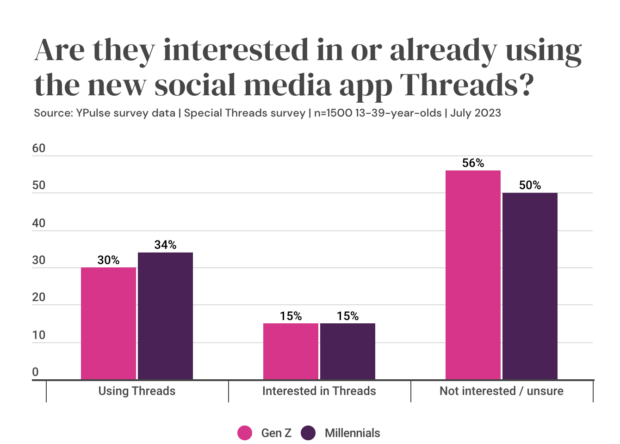
Source: Inforgram
But don’t give up on X just yet. The platform formerly known as Twitter is still the most-used text-based social media app.
X says its user base exceeded 540 million in 2023 and will grow to over 650 million users over the next five years (though Statista reports slightly lower numbers, as well as a dip in users worldwide in 2023).
X platform usage remains high, even if those users aren’t quite sure what to call it:
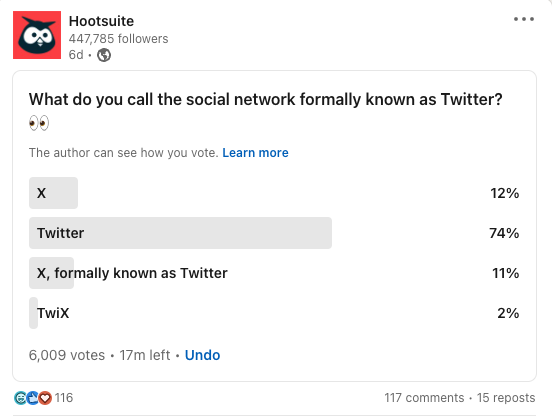

Source: Hootsuite on LinkedIn
But the popularity of these new competitors has made one thing clear: the people are hungry for text, and not just on text-based platforms.
Over on Facebook, old-school text posts are still doing big numbers. Auntie Anne’s has been repurposing top-performing Tweets as Facebook posts for years now, and the engagement those posts earn is eye-popping.
Plus, we all know text-only posts on LinkedIn can take off:
The success of these posts, especially among marketers, makes a ton of sense. They require less time to create (especially if you use a tool like OwlyWriter AI) and are way less likely to get stuck in your approval process.
What are we getting at? No matter what happens at X, text-based social apps aren’t going anywhere. And text-only posts, even on platforms that aren’t considered text-forward, are far from over.
To-do list:
- Secure your usernames on Mastodon, Bluesky and Threads, even if you don’t have time to invest in them yet.
- Look for opportunities to repurpose your text-only content on other platforms (i.e., reposting your Tweets on Instagram).
- Don’t delete your X account yet or reduce the number of times you tweet each week (if you’re feeling fatigued, you can speed up Tweet writing with AI).
- Polish your X marketing strategy and keep a close eye on whether your audience continues to engage on the platform with Hootsuite Analytics.
2. Social platforms will become the hottest new search engines
If you want real insights from real people, Google search results don’t always do the trick.
But you know where you can reliably find a wealth of advice from actual humans?
That’s right: social media. In 2024 and beyond, social media channels represent the biggest threat to traditional search engines.
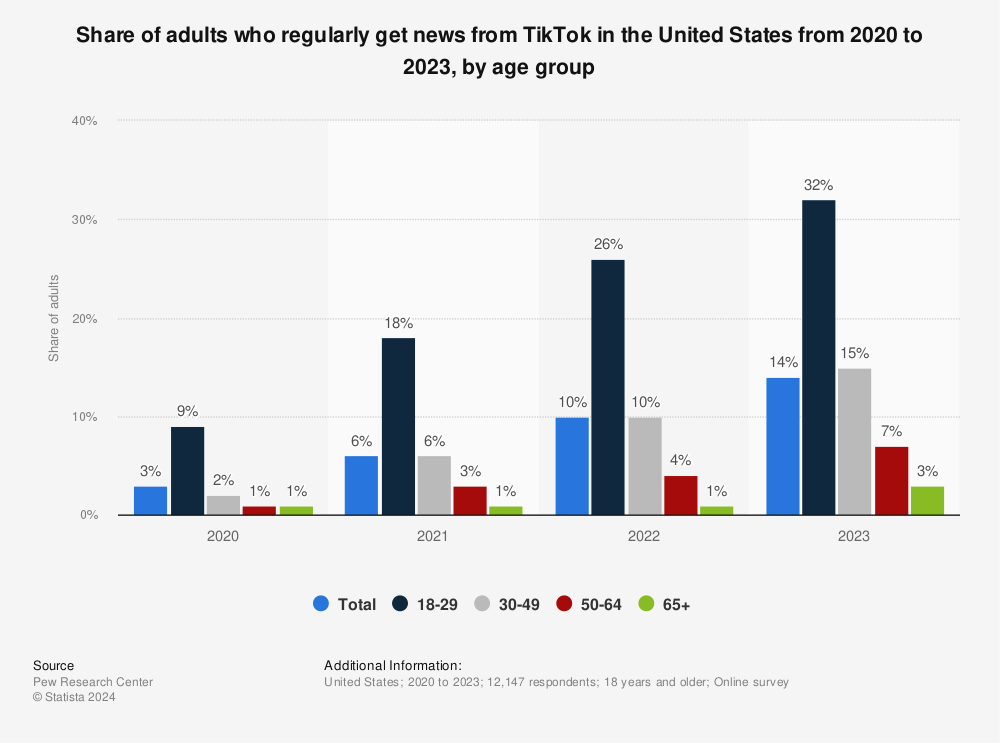

TikTok is now integrating Google search results into its in-app results, and the platform has added robust search tools like Keyword Insights to its Creative Center.
Plus, recent surveys suggest that social media platforms are the second most popular way for Gen Z to research their shopping decisions. It looks like Google is right to worry about TikTok, Facebook, and Instagram encroaching on its territory.
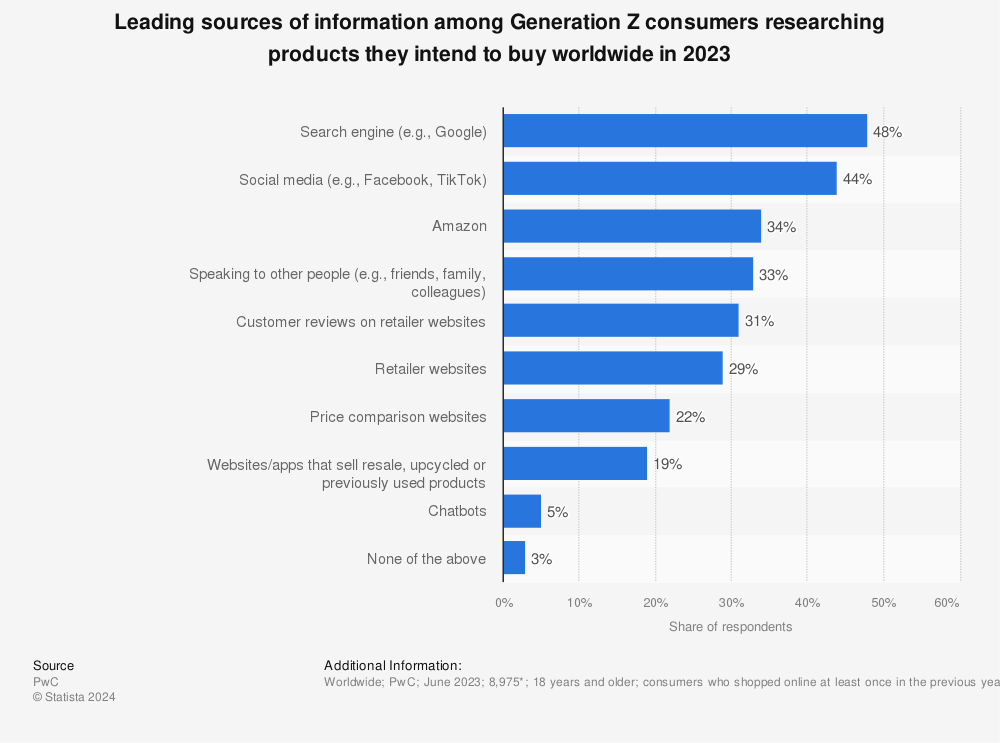
In 2024, if you’re not answering your audience’s questions on social, chances are someone else will (and it might be your competitors).
We talked about social SEO as an important trend in 2022 — and tested our theories in our own experiments — but it’s an even bigger deal now.
Last year, the social SEO tactics we suggested focused mainly on keyword optimization in captions and profiles. Now, social strategies are evolving to address search intent while still producing content that entertains as it educates (edutainment, if you will).
As long as it’s still relevant, evergreen content can show up in social search basically forever. And the more engagement those posts have, the more likely they are to rise to the top of social search results pages.
Here’s an example of an SEO-optimized post created by the Hootsuite social team.
Social search is still new, but as the platforms continue to improve and expand their search functions, we can see this particular social media trend continuing far into the future.
To-do list:
- Continue to use social SEO and keyword research to build out your content calendars. We’ve got tips for Instagram, TikTok, Facebook, YouTube, and X.
- Start creating content that answers common questions in your niche. Educational content is far more likely to show in search results, even months after posting.
- Incorporate social SEO as a component of your strategy, but don’t make it your primary focus.
- If you haven’t tried social SEO yet, watch the video below to get started.
3. Longer videos will make a big comeback
Since we’re still recovering from the whiplash of the short-form video takeover, it feels crazy to say this, but here goes: longer videos are about to be hot again.
When we say longer videos, we don’t mean long videos. Unless you’re in a long-form niche (YouTube video essays, for example), we’re talking a length of two to five minutes per video instead of less than a minute.
There are a few reasons why we expect the algos to reward meatier videos this year.
First, the big platforms keep increasing their max video lengths. Instagram Reels can now be as long as 15 minutes, and TikTok is reportedly testing that length as well. Plus, X (Twitter) rolled out its premium subscription, which allows paid users to upload videos of up to two hours long.
Post by @mattnavarra
View on Threads
Second, user behavior is changing. As we mentioned in trend #2, users now frequently turn to social networks to answer questions they might normally pose to Google or other web search engines. Content creators on social need to be able to answer questions in-depth in their videos, which takes more time.
Finally, people are heading to social media to kill time and be entertained more than ever before. (We’re guessing that’s why Paramount recently uploaded the entirety of Mean Girls to TikTok).
In short, social media is poised to earn an even bigger chunk of the Free Time Pie this year, if you can imagine that. And our brains love getting sucked into stuff, so bank on it: long(er) is the new short.
To-do list:
- Experiment with posting two- to three-minute Instagram Reels and TikToks (and download them without watermarks so you can easily cross-post them).
- Lean into your evergreen video strategy (more timeless, in-depth videos that feature original audio and answer your audience’s questions).
- Keep videos to one part unless absolutely necessary (i.e., don’t divide them into Part 1, Part 2, etc.).
- When posting longer videos, include timestamps in your captions or the video description so viewers can easily navigate through the content.
- Don’t post long videos just for the sake of it. Make sure they’re entertaining and valuable to your followers.
4. Engagement will move from feeds to DMs
These days, social media feeds are busy with news, memes, creator content, ads, organic marketing from brands — and arguments about whether the dress is black and blue or white and gold (Just kidding! 2015 called and asked if you were paying attention!).
The one thing you don’t see much of on social feeds anymore is organic, uncurated posts from friends and family.
There are many reasons for this shift. But the fact that personal updates don’t live in plain sight doesn’t mean they’ve completely disappeared from the social media landscape.
In August 2023, Business Insider interviewed a handful of Gen Z Instagram users for an article ominously titled “Social media is dead.” 22-year-old content creator Tati Bruening said:
“There’s this very weird, unspoken social standard of what’s allowed on Instagram. I know that for my age group, it’s like you give up on it entirely, and then you just post only to your Close Friends or alternate accounts. There’s this sublayer of Instagram that’s much more true to what the app once was, but it is just not viewable to the general public.”
But Close Friends stories and finstas aren’t the only private places Instagram users share personal updates with friends. Even more engagement happens in DMs.
Head of Instagram Adam Mosseri said in a recent episode of the 20VC podcast: “Most of Instagram’s growth has been in stories and DMs.” He also admitted Meta was aware of messaging app Telegram growing into a potentially significant competitor, even though Instagram is “not a messaging app.”
Maybe this is why the team at Instagram has developed many new DM-centered features recently, including:
- Notes, the text-only status updates that live and can be answered in DMs
- Broadcast channels, a one-to-many messaging system inspired by Telegram
- Improved guardrails against unsolicited messages
So, what does this mean for social marketers?
First, tracking brand-related engagement is more difficult when it happens in the privacy of DMs — off-limits territory for social listening tools and traditional analytics. But that doesn’t mean it can’t yield significant business results (see our tips for tracking this type of dark social below).
Second, brands and organizations need to get comfortable with the fact that DMs are the preferred communication method for most social media users. This goes for B2C conversations too, which means that social media will become even more of a customer service channel in coming years.
To-do list:
- Encourage your audience to DM you with questions and feedback.
- Get your social team ready to handle customer service inquiries. Give them tools (like Hootsuite Inbox) that will help them keep track of and easily answer social messages from all your accounts across networks.
- Set up automated responses for simple, frequently asked questions and the times of day when your team is offline.
- Use UTMs to track (at least some of) the traffic you get from DM shares.
- If your organization uses social media to share timely content, news, or important PSAs, consider starting an Instagram Broadcast Channel. (Note: At the moment, the feature is only available to users with Creator accounts. Keep an eye on Adam Mosseri’s own Broadcast Channel for updates.)
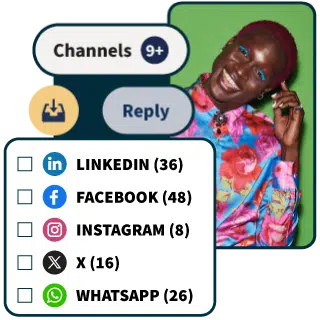
Reduce response time (and your workload)
Manage all your messages stress-free with easy routing, saved replies, and friendly chatbots. Try Hootsuite’s Inbox today.
5. Shares will matter more than likes, comments, or followers
Every social marketer wants to expand their reach, but if you’ve ever tried to buy followers or likes, you know the results can be… disappointing. Especially when your boss asks you to prove how those investments have paid off.
Comments, likes, and followers can all be faked. Views and impressions are easily inflated. But there’s one engagement signal that’s much harder to game: shares.
Unlike comments, likes, followers, or views, shares represent actual value. When someone shares your content in Stories, DMs, or off-platform, you know they’re willing to vouch for you to their own audience.
Don’t get us wrong: comments and likes are still valuable engagement signals. But if you design your content to be shared, the likes and comments will still follow. The reverse isn’t always true.
Platforms like Instagram, TikTok, and X have either made share counts public or are testing doing just that — and if that’s not a nod to their importance, we don’t know what is.
Looks like @instagram has begun rolling out share/comment counts.
UX wise, it looks sharp. Although, it does seems a little counterintuitive following the removal of like counts all those years ago. pic.twitter.com/fANF1rBCpV
— Nick Alessi (@nckalessi) August 10, 2023
If you want to make sure your content gets shared more in 2024, start by looking at what’s already working. (Hint: Hootsuite Analytics makes this part pretty easy.) What has your audience responded well to in the past, and how can you make more of that?
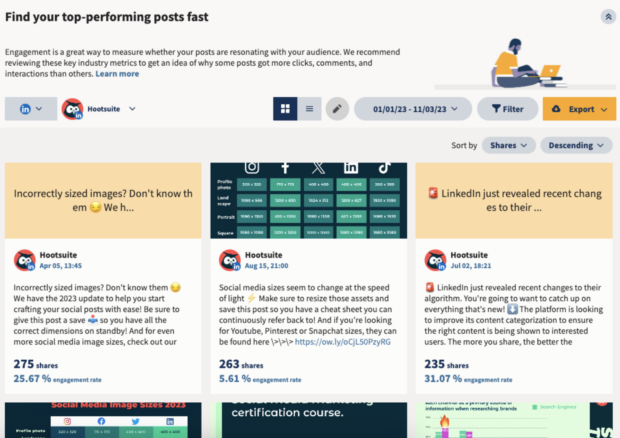

Then, when you’re creating new content, try running it through social media consultant Rachel Karten’s shareability test before you hit Post.
But whatever you do, don’t buy shares (or likes, comments, or followers). At best, you’ll hear crickets. At worst, you’ll earn a platform suspension or a permanent ban.
To-do list:
- Get really clear on who you’re making content for and what they care about.
- Investigate your top-shared posts using a tool like Hootsuite Analytics. What made them so successful? How can you repeat those wins?
- Before you post new content, run it through a shareability test like Karten’s. If your target audience isn’t likely to share your post, what can you adjust to hook them?
- Start paying attention to shares in your regular marketing reports.
6. Telegram might become the next super app
You already know the group chat is the new Facebook status (see trend #4), which is why messaging apps like Telegram are in such a sweet position to skyrocket this year. The privacy-focused chat platform has over 800 million monthly active users and gets around 2.5 million new sign-ups per day. (Seeing the dollar signs yet?)
Although Telegram has been around since 2013, it didn’t become the full-fledged social media network it is today until much more recently. That’s thanks in part to Ukraine’s President Volodymyr Zelensky, who has consistently used the app to communicate during the war with Russia.
What was once an app for sending secure messages to friends now has many enticing social features. And the platform continues to add more, which is why we think it’s in a strong position to become one of the next super apps.
Some current Telegram features include:
- Group chats (up to 1,000 users), secret chats, and video chats
- Support for media, links, files, music, and voice in chats
- Stories that let you share photos and videos for a limited duration
- Broadcast channels for sending out messages to large audiences
- Payment bots to send money between buyers and sellers
- Telegram Passport for secure personal identification verification
- Sponsored messaging via the Telegram Ad Platform
The app added an advertising platform in 2021, which allows brands to send sponsored messages to channels with 1,000+ subscribers. Marketers might want to consider integrating Telegram into their paid strategies and striking while the iron is hot on this platform.
To-do list:
- Government agencies, in particular, might consider following Zelensky’s lead and creating broadcast channels on the app to keep citizens informed with less risk.
- Cross-promote your broadcast channel (with links) to your audience on your other social media networks.
- Sign up for the Telegram Ad Platform and experiment with sponsored messaging.
7. The fediverse is the future of social media (but it’s not here yet)
Mastodon. Hive. Bluesky. Threads. What do these social networks have in common?
Sure, each has been touted as Twitter/X’s heir apparent. But they’re also either current or future examples of decentralized social media networks, and they may be a sign of things to come.
But before we get too far into it, a refresher on “decentralized platforms” (because this stuff can get confusing).
Unlike traditional social networks, decentralized platforms use blockchain or peer-to-peer networks to distribute information across many servers.
That means your data isn’t confined to a single server, and no one entity controls it. If enough of these networks are connected, you can communicate seamlessly across them.
That’s exactly what the fediverse, or “federated universe,” is all about. Users on one network in the fediverse can follow, interact, and share content with users on another. The fediverse is big on privacy, independence, community and connection.
That said, the fediverse may not be our social reality just yet.
The team behind Threads certainly seems excited to move towards the decentralized model, but so far, Threads still operates a lot like other traditional social networks.
And while the shakeup at X this year had some social marketers questioning the concept of traditional, centralized networks, the platform formerly known as Twitter has managed to retain most of its users.
Plus, most existing decentralized networks are still too technically complex (see the many “How does Mastodon/Bluesky even work??” posts on X) for most regular users.
To-do list:
- If you haven’t already, secure accounts and start exploring platforms like Mastodon and Bluesky. There’s no harm in preparing for the future.
- Start building out your community-oriented social strategy. It’ll be a big part of the decentralized future, but it’s just as relevant for the traditional networks.
8. Every grid post will be a photo dump
We first talked about photo dumps back in 2022, but at the time, they seemed like a passing fad.
Apologies: our crystal ball must have been malfunctioning that day.
Photo dumps, formerly known as carousels, are now the only way to post on Instagram — and since TikTok introduced photo mode, they’ve taken off on that platform too.
(And seriously, no one’s calling them carousels anymore.)


Source: Jess Val on TikTok
You’ve probably noticed that your friends are posting on Instagram less frequently these days. But do us a favor and check out their last few posts — they’re photo dumps, aren’t they?
Those friends aren’t alone, either. There are now more than 3.6M Instagram posts using the #photodump hashtag.
And while the name may imply a lack of curation or strategy, that’s definitely not the case.
The multi-photo format allows creators and brands to tell longer stories, participate in photo-specific trends, and connect with their audience in a way that feels authentic and unfiltered.
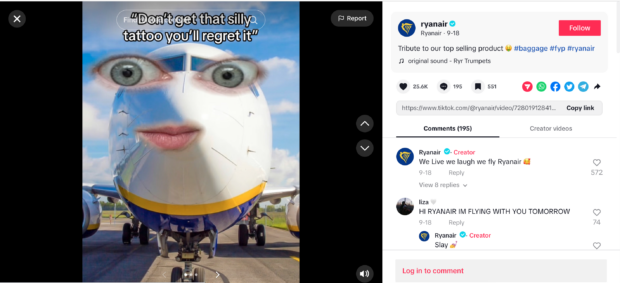

Source: TikTok
They’re also a great way to deliver a lot of information without investing in a costly, production-heavy video. On Instagram, you can share up to 10 photos or videos in a single post, and on TikTok, you’ve got up to 35 slides.
Plus, carousels, sorry, photo dumps, are still the top-performing format on Instagram, earning more reach and engagement than Reels or solo posts.
Better storytelling, more reach, and higher engagement for less money? Yeah, we’d call that a format worth investing in.
To-do list:
- Plan your photo dumps carefully — that first photo is key! Grab your audience with a hook that’ll have them scrolling all the way through.
- Watch for photo-specific trends, especially on TikTok. If you can come up with a take that makes sense for your brand, high engagement is almost guaranteed.
- If your first photo dump doesn’t take off, keep testing. Play around with different styles and lengths of carousels.
- Don’t try to get too sales-y. Photo dumps are the perfect fit for your educational or trending content.
9. LinkedIn will deprioritize personal content (and win more love from Gen Z)
We watched closely as COVID-19 turned LinkedIn from a place for professional updates, career advice, and work brags to a feed filled with personal anecdotes and weekend selfies.
But just as we were warming up to the professional platform getting personal, LinkedIn started giving some signals that it would be returning to its roots.
In fact, LinkedIn has already rolled out some algorithm changes that prioritize professionalism, including one that focuses on “knowledge and advice,” especially among subject matter experts and people within a user’s network.
That’s because, LinkedIn says, its users find content the most valuable when it’s rooted in knowledge, especially if it was posted by someone they know.
Subtext: if you want your posts to go viral on LinkedIn in 2024, you’ve got to work even harder on building out your personal network and followers.
Another indicator that things are skewing more professional is LinkedIn’s new Top Voice badge feature. The platform grants these badges to creators who “share valuable expertise through content that demonstrates their unique, original contributions to a topic.”
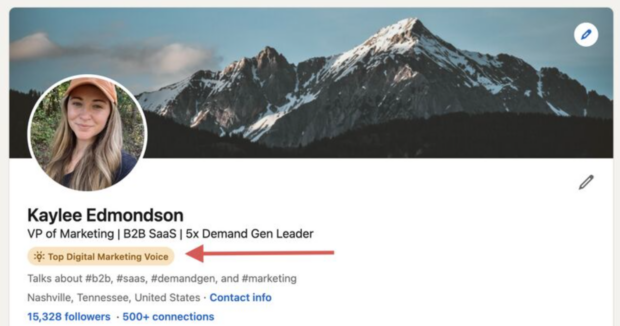

Source: Kaylee Edmondson on LinkedIn
The platform clearly wants to reward users who share content based on their professional expertise.
One more important trend to note for LinkedIn in 2024: Gen Z will gain a greater share of the platform’s user base. They’re its fastest-growing demographic, and they’re already outpacing their elders when it comes to adding connections on the platform.
And that’s not just because millions of Gen Z’ers age into the job market each year. It’s also because, as critics posit, younger internet users are seeking a place of earnest celebration (and one free of the overly curated, aspirational, and FOMO-inducing content on Instagram and TikTok).
To-do list:
- Scale back the personal posts in favor of professional content and posts that spotlight your expertise.
- But prioritize growing your personal network and follower base (on LinkedIn, users respond best to content posted by people they know in real life or are familiar with online).
- Reinforce yourself or your brand as a subject matter expert.
- Tidy up your LinkedIn strategy and stay active.
- Don’t ignore an emerging Gen Z audience on the platform (you can always use our LinkedIn post generator if you don’t speak Gen Z).
10. TikTok Shop will spark a re-emphasis on authenticity
We’ve been predicting the big TikTok ecommerce boom for a while, but it was still surprising to see just how fast the ForYouPage morphed into a shopping app with the release of TikTok Shop in the U.S. in September 2023.
Just a few months later, TikTok is at the center of the social shopping trend. The app’s in-house storefront and fulfillment service is fast becoming an influencer favorite. And if you’ve spent much time scrolling lately, you already know the algorithm seems to be rewarding users who promote it.
With TikTok handling the shipping and fulfillment, too, there’s less incentive for money-makers to take their sales and affiliate rewards outside of the app.
But it’s not all roses and dollar signs. TikTok users are already reporting scams and knock-offs and questioning creators’ sincerity. There has also been a steep rise in “deinfluencing” content, or content that helps users with overspending and impulse shopping.
So, what does this mean for sellers? Besides the obvious — they need to get their products up on TikTok, like, yesterday — we predict that creators who promote their goods in a more authentic way will have the most success on TikTok Shop.
You may see influencers lean more heavily into product placement and detach from overt advertising tactics offered by TikTok Shop.
To-do list:
- If you’re eligible, put your products up on TikTok Shop.
- Promote your products in a way that still feels authentic and not sales-y (that’s what made TikTok so special to begin with).
- Keep a close eye on your TikTok analytics as you start to sell on TikTok. Note whether your promotional videos are doing better than the rest.
- Try sitcom-style product placement (casually including products in videos without calling them out explicitly).
11. You won’t need a BeReal strategy
Hands up, who else placed their bets on BeReal in 2023?
The real-time selfie app captured our hearts, minds, and marketing strategies last year, and why not? An endless feed of unfiltered, spontaneous updates felt like the perfect antidote to highly curated Instagram feeds.
But the app’s popularity came and went like the disappearing selfies that made it so enticing. Although BeReal amassed over 73 million active users at the height of its popularity, recent stats show that only a third of those users are still active on the platform.
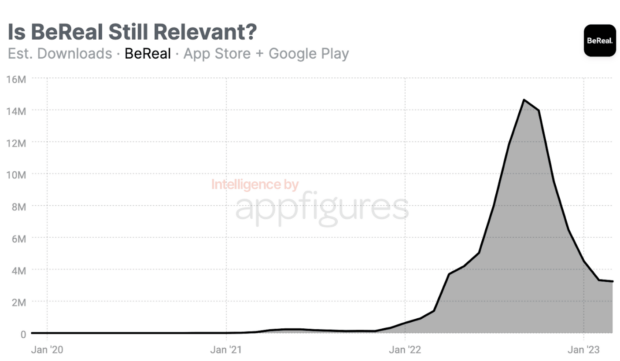

Source: Appfigures.com
Sadly, we don’t have high hopes for BeReal’s resurgence — at least for brands, and here’s why: the app’s swift rise and fall shone a light on a broader, more salient social media trend. These days, users are quick to adopt shiny new trends, but they’re even quicker to abandon them.
The steady decline in BeReal’s monthly users proved that, once the novelty wears off, users — especially Gen Z users — are quick to uninstall.
To-do list
- Don’t divest entirely from BeReal. Keep your username and keep an eye on trends. Some apps don’t appeal to mass audiences but still thrive among certain niches and demographics
- Note that BeReal will delete your account if it’s inactive for two years, so pop in from time to time and post a selfie or two
- Remember that platforms themselves can be micro-trends. Strike while the iron is hot, but don’t put all your eggs in one basket or expect them to deliver long-term
12. TikTok will continue to be the birthplace of video trends
You know those TikTok jokes about Reels being the place where trends go to die? No? Here’s an example:
The idea is that social media trends start making rounds on Reels after they surface — and sometimes even get old — on TikTok.
But let’s be clear: Even if Reels are a bit behind on shiny new trends, they’re still a very relevant (and continuously growing) format, and your brand should definitely be making them.
That said, the TikTok to Reels trend pipeline is real.
TikTok’s demographic skews younger than Instagram’s, and the platform is always a couple of steps ahead of its Meta-owned rival in terms of editing features, filters, and audio clips. It’s also, by nature, more creative and “unhinged” (more on that in the next section) than Instagram.
All this means that, for now, TikTok is likely to remain the mothership of short video trends — and keeping an eye on it will help you stay ahead of your Instagram-focused competitors.
To-do list:
- Scroll! Your For You page is full of content trends waiting to be discovered.
- Take note of how brands are participating in trends and how their audiences are reacting to it.
- Fold the ideas that seem the most relevant to your business and social goals into your content calendar — and start testing!
- If you are in a highly regulated industry (or are not ready to start filming and posting quite yet), keep a burner account to stay informed, but don’t worry about posting.
13. The unhinged social media manager will calm down a little
You’ve probably noticed brands becoming more fun and daring with their online personas in the last few years. This social media trend not so coincidentally overlapped with TikTok’s rise to popularity as a B2C-friendly network. It’s an entertainment platform, after all, and businesses that can’t, well, entertain their TikTok audiences may be better off looking for success elsewhere.
That’s more or less how the unhinged social media manager persona was born. Social media managers fully embraced the language of the internet (niche memes, edgy humor, obscure Gen Z lingo, trending sounds, etc.) to create relatable, often chaotic, sometimes a bit shocking — and ultimately, engaging — content.
Getting spicy and subverting expectations paid off for a few trailblazers (hi Duolingo, hello Scrub Daddy), helping them go viral and inspiring others to follow suit. Before long, a pizza chain was posting about stuffed crustussy (?!?), a travel bag producer was telling their audience of “idiots” who didn’t know how to adjust straps to “shut up,” and every other brand account was complaining about their boss in the first person.
And then… it started getting old. The more brands leaned into the chaos, the less authentic the SMM-turned-comedian voice felt. With such widespread adoption, it lost the shock value and a lot of its original appeal. And let’s not forget the poor souls who accidentally took things a bit too far and ended up in hot water.
So, is there a happy medium? Does being funny and relatable outweigh the risk of reputational damage? Is the unhinged social media manager trope slowly dying?
The answer is: it’s complicated.
The unhinged SMM is the polar opposite of the social marketer limited by inflexible brand guidelines, complicated approval processes, and leaders who don’t understand social media. And most organizations would benefit from building a relatable online personality, learning to speak their audience’s language, and giving social media managers more creative freedom.
Those who decide to go a bit unhinged need to make sure that it’s part of a smart strategy (thorough audience research and clear goals) rather than just posting the team’s only chronically online Gen Z person’s jokes without approval.
To-do list:
- Build trust in your social media team within your organization. SMMs know social better than senior leaders — their judgment should always be taken seriously.
- Get everyone on the same page about what’s off-limits. Include non-negotiables in your social media policy (e.g., offensive language, explicit jokes). Be specific.
- Revise your social media approval workflows. Make sure that your process never gets in the way of creative and timely ideas.
- Take note of how people within your niche communicate. How casual are they? What jokes do they use? Consider how this style of communication aligns with your goals on social media. Then, rework your style guide to reflect your findings.
- If you operate in a highly regulated industry or your audience demographics skew older, don’t force it. Chaotic humor might not be for you — and that’s ok.
14. Social isn’t moving into the metaverse quite yet
2021 and 2022 were full of news about Mark Zuckerberg’s then-new project, the metaverse.
Since Meta is best known as a social media company (home of Facebook, Messenger, Instagram, WhatsApp, and, as of 2023, Threads), social media managers everywhere rightfully wondered how the metaverse would change social — and their jobs.
But, in late 2023, we’re not hearing as much buzz about the metaverse — at least not in the context of social media.
Since Zuckerberg dubbed 2023 “the year of efficiency,” engaging in several belt-tightening tactics, the expensive metaverse project has moved out of the spotlight — but it hasn’t been completely deprioritized. Meta continues to invest in it, but more for gaming than anything else. This aligns with independent predictions on how the metaverse will make money in the coming years:
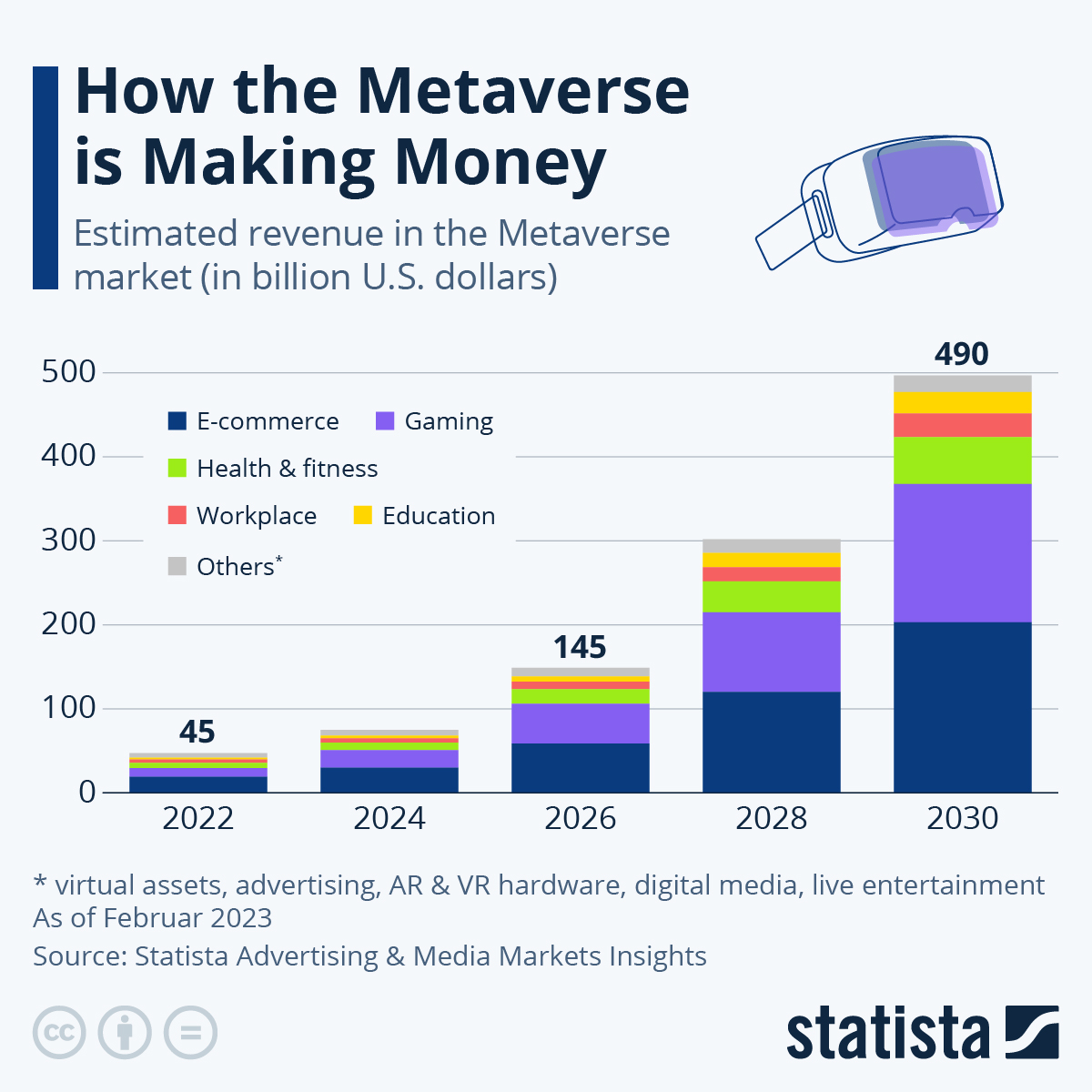

So, what does the future hold for Meta’s metaverse? Time will tell. But for all we know, social media isn’t moving into virtual reality quite yet.
To-do list:
- Keep an eye on industry news to follow new developments.
- If you have a friend with a VR set, go play some mini golf with them — it’s fun!
15. Social media managers will become best friends with AI
Is ChatGPT coming for your job? Do you need to rebrand yourself as a prompt engineer? Is AI-written content good enough, kind of ok, or absolute hot garbage?
The jury of LinkedIn thought leaders is still out, but we’ve got some answers.
The TL;DR of our take is: Generative AI is a super valuable tool for savvy marketers. It won’t take your job (unless you’re really bad at it — and we know that’s not true!). It will make it easier, and it will help you get better results faster.
And we have proof. Our team at Hootsuite ran an experiment where we tested a human writer against ChatGPT on X (formerly Twitter). The results were interesting — ChatGPT generated more engagement, but the human-written captions got more impressions. You probably see where we’re going with this: Humans and AI work great as a team.
AI can help you get words on the page faster, brainstorm ideas, and create many variants of a specific message for testing. But social media managers are still the brains behind it all.
Tools like ChatGPT will allow you to spend more time thinking about your goals, interacting with your social audience, testing new tactics, measuring your results, and so on.
Simply put, AI will help you become a more strategic social marketer.
To-do list:
- Spend some time playing with a free AI tool like ChatGPT. A small time investment now will save you tons of time in the future.
- Try OwlyWriter AI, an AI tool Hootsuite built specifically for social media managers. You can use it to:
- Write new social media captions from scratch in a specific tone of voice
- Write posts based on a link (e.g., a blog post or a product page)
- Generate post ideas based on a keyword or topic (and then write posts expanding on the idea you like best)
- Identify and repurpose your top-performing posts
- Create relevant captions for upcoming holidays
- … and then easily schedule those posts to go live at the optimal times, across all your social profiles.


Craft perfect posts in seconds
OwlyWriter AI instantly generates captions and content ideas for every social media network. It’s seriously easy.
Bonus: Here’s a bunch of free tools that will help you get started with AI.
16. You won’t ignore YouTube Shorts anymore
Remember when YouTube Shorts first launched in 2021? Many dismissed it as another “TikTok clone” and went back to creating content for the networks they were familiar with.
If we could, we’d go back to those not-too-distant days and give ourselves a good shake. Because YouTube Shorts is more than just a flash in the pan.
According to Google Trends, American interest in YouTube Shorts (generally a reliable indicator of business interest in the platform) has increased by more than 500% since 2021.
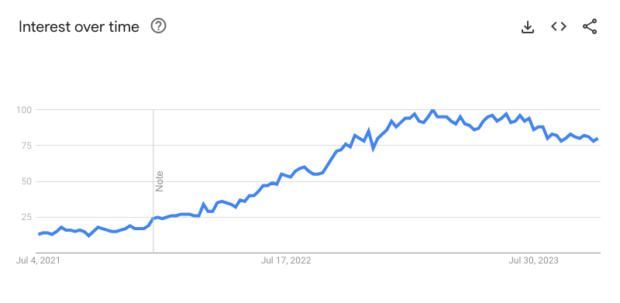

Source: Google Trends
This isn’t just a stateside phenomenon, either. In 2022, there were 1.5 billion monthly active users on YouTube Shorts. In 2023, that number rose another half billion.
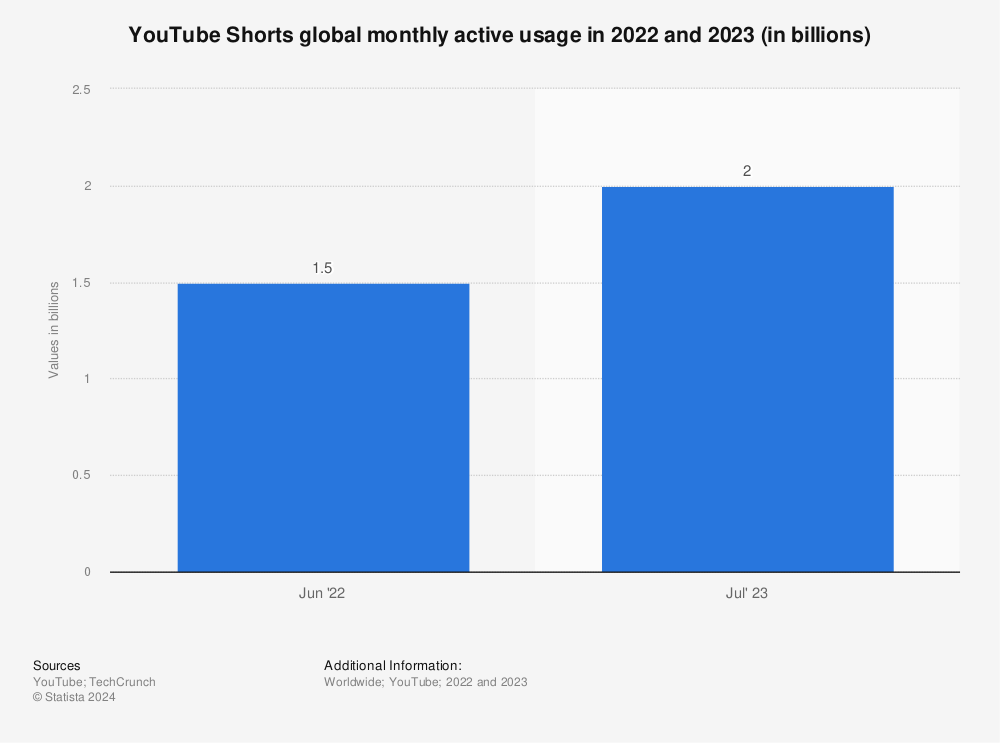

Users who’ve stuck with the platform are seeing big gains. But if you’re not using Shorts yet, there’s still time to get on board.
On our own Hootsuite Labs channel, we only started posting Shorts regularly back in April 2023. We now earn thousands of views, hundreds of likes, and a respectable stream of new channel subscribers each week.
If you already have a YouTube channel, Shorts could be a huge opportunity to connect with a new audience. (And if you’re already making TikToks or Instagram Reels, you’ve got a library of short-form video content just waiting to be repurposed.)
Say hello to content links!
🩳 Edit any Short in Studio Desktop
🔗 Add a link to any related video, long, Short, or Live, public or private
🤳 Get a one-click, Remix-style button right on the Short
🤔 Use it to bridge Shorts to long-form, link multi-part Shorts, drive to live,… pic.twitter.com/tjmYqEWEdZ— YouTube Liaison (@YouTubeLiaison) August 10, 2023
You can even link your Shorts to any related YouTube video: long, Short, public or private. It’s a great tactic to drive up subscribers on the platform that’s already considered one of the most creator-friendly around.
In Short (sorry), if you’ve been waiting for a push to get on YouTube Shorts, consider this your official friendly shove.
To-do list:
- If you don’t already have one, secure your YouTube channel.
- Start watching YouTube Shorts so you can get a sense of what’s popular on the platform.
- Sketch out the basics of your Shorts marketing strategy.
- Repurpose your existing short-form videos (TikToks, Reels) that have performed well on other platforms.
- Use Hootsuite to schedule your Shorts in advance and analyze their performance.
Research
We’ve compiled research from several different sources to bring you the most data-backed predictions:
Save time managing your social media presence with Hootsuite. From a single dashboard you can publish and schedule posts, find relevant conversions, engage the audience, measure results, and more. Try it free today.

